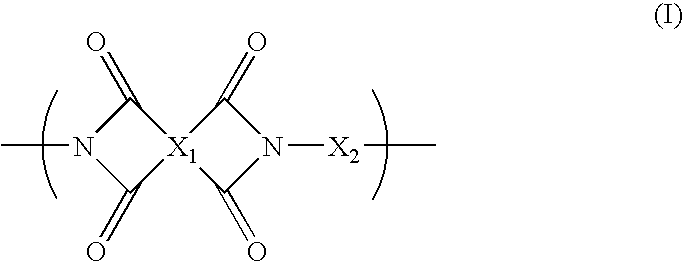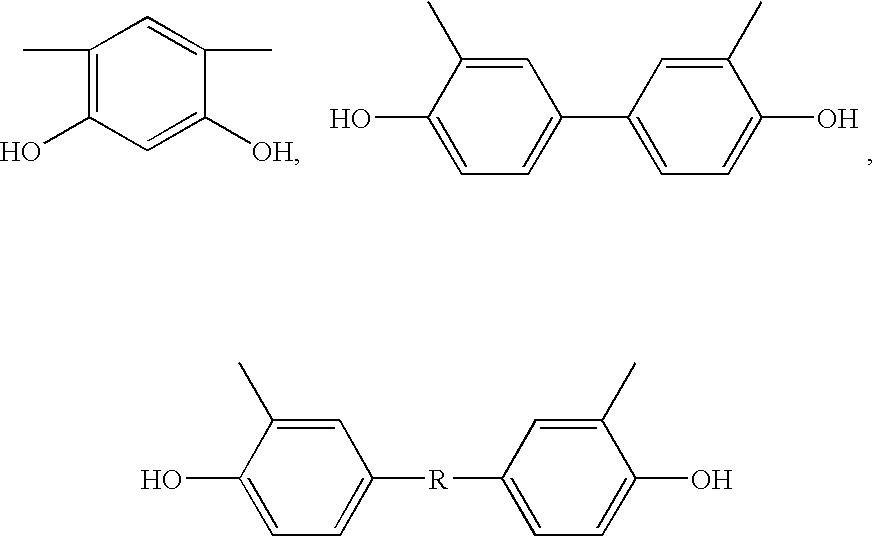Polybenzoxazole Polymer-Based Mixed Matrix Membranes
- Summary
- Abstract
- Description
- Claims
- Application Information
AI Technical Summary
Benefits of technology
Problems solved by technology
Method used
Image
Examples
example 1
Synthesis of poly(6FDA-HAB)polyimide
[0059]A aromatic poly[2,2′-bis-(3,4-dicarboxyphenyl)hexafluoropropane dianhydride-3,3′-dihydroxy-4,4′-diamino-biphenyl](poly(6FDA-HAB))polyimide containing pendent —OH functional groups ortho to the heterocyclic imide nitrogen in the polymer backbone was synthesized from 2,2′-bis-(3,4-dicarboxyphenyl)hexafluoropropane dianhydride (6FDA) and 3,3′-dihydroxy-4,4′-diamino-biphenyl (HAB) in NMP polar solvent by a two-step process involving the formation of the poly(amic acid) followed by a solution imidization process. Acetic anhydride was used as the dehydrating agent and pyridine was used as the imidization catalyst for the solution imidization reaction. In this example, a 250 mL three-neck round-bottom flask equipped with a nitrogen inlet and a mechanical stirrer was charged with 5.9 g (27.3 mmol) of HAB and 40 mL of NMP. Once HAB was fully dissolved, a solution of 6FDA (12.1 g, 27.3 mmol) in 40 mL of NMP was added to the HAB solution in the flask. ...
example 2
Preparation of AlPO-14 / poly(6FDA-HAB) mixed matrix membrane
[0060]An AlPO-14 / poly(6FDA-HAB) mixed matrix membrane containing 30 wt-% of dispersed AIPO-14 molecular sieve with thin plate morphology in a poly(6FDA-HAB) polyimide continuous matrix (AlPO-14 / poly(6FDA-HAB)) was prepared as follows: 2.4 g of AlPO-14 molecular sieves (prepared in accordance with the process disclosed in U.S. Ser. No. 11 / 941,445 filed Nov. 16, 2007, incorporated by reference herein in its entirety) were dispersed in a mixture of 14.0 g of NMP and 20.6 g of 1,3-dioxolane by mechanical stirring and ultrasonication for 1 hour to form a slurry. Then 8.0 g of poly(6FDA-HAB)polyimide polymer was added to the slurry and the resulting mixture was stirred for 2 hours to form a stable casting dope containing 30 wt-% of dispersed AlPO-14 molecular sieves (weight ratio of AlPO-14 to poly(6FDA-HAB) is 30: 100) in the continuous poly(6FDA-HAB)polymer matrix. The stable casting dope was allowed to degas overnight.
[0061]An ...
example 3
Preparation of AlPO-14 / PBO(6FDA-HAB) mixed matrix membrane
[0062]The AlPO-14 / poly(6FDA-HAB) mixed matrix membrane prepared in Example 2 was thermally heated from 50° to 400° C. at a heating rate of 5° C. / min under N2 flow. The membrane was held for 1 hour at 400° C. and then cooled down to 50° C at a heating rate of 5° C. / min under N2 flow to yield AlPO-14 / poly(6FDA-HAB) mixed matrix membrane.
PUM
| Property | Measurement | Unit |
|---|---|---|
| Temperature | aaaaa | aaaaa |
| Angle | aaaaa | aaaaa |
| Temperature | aaaaa | aaaaa |
Abstract
Description
Claims
Application Information
 Login to View More
Login to View More - R&D
- Intellectual Property
- Life Sciences
- Materials
- Tech Scout
- Unparalleled Data Quality
- Higher Quality Content
- 60% Fewer Hallucinations
Browse by: Latest US Patents, China's latest patents, Technical Efficacy Thesaurus, Application Domain, Technology Topic, Popular Technical Reports.
© 2025 PatSnap. All rights reserved.Legal|Privacy policy|Modern Slavery Act Transparency Statement|Sitemap|About US| Contact US: help@patsnap.com



